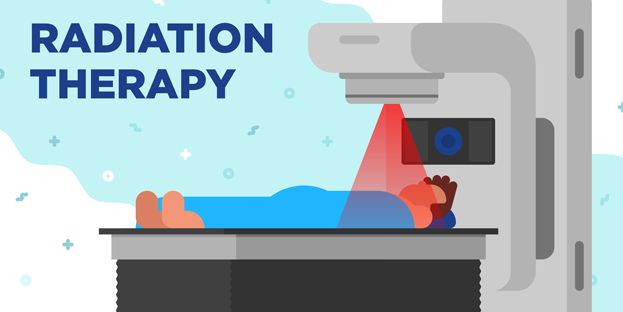What is Radiation Therapy?
Radiation therapy uses waves of electronically generated radiation to treat cancers and tumors, as well as some other conditions.
This Radiation breaks up the DNA of cancer cells in a way that disrupts their growth and division and can even kill them.
The form of radiation used in cancer therapy is a high-energy type known as ionizing radiation.
Radiation therapy are of 2 types;
External beam radiation therapy.
During this type of radiation, the high-energy beams come from a machine outside of your body that aims the beams at a precise point on your body. The beams are guided & planned as per the CT Scan image taken.
Internal Radiation Therapy
This Radiation treatment is known as brachytherapy radiation in which radioactive implant is placed inside your body close to the tumour.
Sometimes the patient only is given radiation treatment, otherwise they are given concurrent treatment along with Chemotherapy or surgery (Pre or Post)
More than 70% patients need Radiation Therapy for Cancer Treatment in India.
How does radiation therapy work on people with cancer?
- Your doctor may suggest radiation therapy at different times during your cancer treatment and for different reasons, including:
- As the only treatment for cancer
- Before surgery, to shrink a cancerous tumour (neoadjuvant therapy)
- After surgery, to stop the growth of any remaining cancer cells (adjuvant therapy)
- In combination with other treatments, such as chemotherapy, to destroy cancer cells (Con-current)
- In advanced cancer to alleviate symptoms caused by the cancer. (Palliative treatment)
What are the Side effects?
The side effects of radiation therapy occur when non-cancerous cells are also affected by the treatment.
Side effects varies from patient to patient depending on their case history & other factors.
Short-term side effects
- Short-term effects of radiation treatment are:
- Lethargy or fatigue
- skin irritation, including swelling, blisters, and a sunburned or tanned appearance
- Nausea, Vomiting, and Diarrhoea
- Occurs Rarely- a drop in the number of white blood cells or platelets
Long-term side effects
Long-term effects also depend on the site of treatment and can include:
- Stiffening and restricted movement: After neck therapy, for example, the jaw can stiffen. This can occur as a result of tissue scarring. Exercises may be advised after cancer surgery and radiation therapy to help loosen movement.
- Skin effects: These include delayed wound healing and a spidery red or purple appearance caused by dilated capillary blood vessels. There can be skin darkening as well on the affected area but eventually subsides.
- Diarrhoea and bleeding: These can occur when abdomen receives radiation therapy.
Not all of the above are likely to occur with radiation therapy. The likelihood of getting any one of the longer-term side effects depends largely on the individual& the treatment facility they are being treated in.
Are there Special Dietary Needs for patients?
Radiation can cause side effects that makes it difficult to eat Problems such as mouth sores, nausea and throat problems can occur. Since your body uses a lot of energy to heal during radiation therapy, it is important that you eat enough calories and protein rich foods to maintain your weight during treatment& to avoid fatigue. You can consult an Inhouse Nutritionist for a proper diet plan as it can vary from patient to patient
Work Routine during Radiation Therapy
Many people are able to work full-time during radiation therapy. Few of them can work only part-time or not at all. How much you are able to work depends on how you feel. Ask your doctor or nurse what you may expect from the treatment you will have beforehand.










